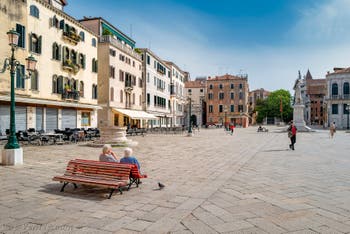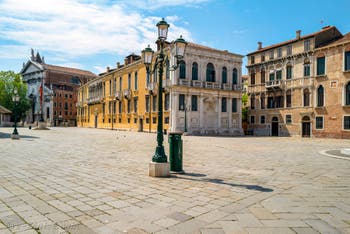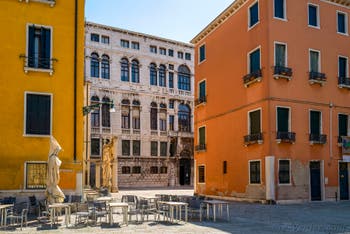Squares Arsenal | Hunchback | Dogana | Colleoni | Rioba | Piazzetta St. Mark | Stefano | Rialto Vecchio
The Campo Santo Stefano in Venice

The Campo Santo Stefano Campo Santo Stefano, which was also called Campo Morosini after the famous occupant of one of the palaces adjoining it, is one of the largest in Venice.
It gives you a real sense of space when you arrive there from the small Calle de Spezier, which is very narrow, but nevertheless represents a privileged axis for getting from Piazza St. Mark to Campo San Stefano: it's almost straight ahead, which is rather rare in Venice over such a distance!
Like being on terra firma
Campo Santo Stefano is considerably longer than it is wide, stretching in length for almost 300 metres from the church of Santo Stefano to the gardens of Palazzo Franchetti Cavalli Gussoni.It also has a distinctly paunchy centre, level with the statue of the writer Nicolò Tommaseo.
The fault lies with Palazzo Loredan, which breaks the rectilinear perspective that the campo would have had without it.
This palazzo has also had a not inconsiderable effect on the general atmosphere and current appearance of Campo Santo Stefano: it almost completely hides the view of the little Rio San Vidal that runs alongside it.
Yet it is this same little Rio that runs just before Campo San Vidal and gives it some of its charm. What a shame!
As a result, you get the impression of a Campo on dry land, with only two tiny tongues of water to skirt it, in the corner of Palazzo Loredan and at the end of Palazzo Barbaro.
A pedestrian motorway
Campo San Stefano is a dual thoroughfare from San Marco or even San Lio and Rialto, and this is due to the presence of the Accademia Bridge, a veritable suction pump for pedestrian traffic from this part of Venice towards the District of Dorsoduro.And if you like certain Campi for stopping off, on Campo Santo Stefano, for a good part of the day, you're just passing through. It's really only at lunchtime and especially in the evening that the Campo reveals a life of its own, a true Campo life!
Long live the children of Venice!
As on all the Venetian Campi, the nicest time is in the late afternoon, when the children come out of school and invade the Campi.Life is here: games, shouts, chases, laughter!
It has to be said that for little Venetians, the Campi is the only place where they can enjoy the sunshine, given the narrowness of most of the Calli, which are not very suitable for playing ball or cycling among the passers-by.
Campo Santo Stefano is no exception to the rule, and if you want to see it at its most friendly, it really is at its most lively and charming around five o'clock in the evening.
Bullfighting
In the past, but the tradition stopped in 1802, bull runs were held here.Unfortunately, during the last race, one of the spectator stands collapsed, injuring a number of people, which put an end to these events.
You can imagine the Campo Santo Stefano, now so quiet, echoing with the sound of hooves and the passionate cheers of the spectators!
Games and Tournaments
But in its festive period, there were also games and tournaments held on Campo San Stefano.
The Campo Santo Stefano In fact, it was just after the festival held here for a tournament that the Duke of Ferrandina, Antonio Castriota, was killed on February 17, 1549 by two Venetians who had mistaken him for... another.
A love affair gone wrong, and above all the fault of the mask he wore.
Just goes to show that anonymity can also be dangerous and not just practical...
Market Square in 1807
In 1807, the weekly market, which had previously been held in St. Mark's Square, was moved to Campo Santo Stefano.However, this was short-lived as in 1809, the market in Campo Santo Stefano was in turn moved to Campo San Polo.
In the centre of the Campo a statue renamed “il Cagalibri” by the Venetians
There's a statue right in the centre of Campo Santo Stefano that has become a favourite meeting place to catch up with friends.In fact, you can often see couples and friends meeting there while others wait patiently...
The statue of Nicolò Tommaseo, writer, is quite imposing and has been unkindly renamed by the Venetians because of the pile of books that seems to fall behind his overcoat.
But let a son of Venice tell you that himself:

The Campo Santo Stefano
“It's Niccolò Tommaseo: his sullen statue in Piazza Santo Stefano rests his bottom on a stack of bound volumes, beneath the flaps of under his overcoat flows a diarrhoeic emptying of codes and volumes.
The Venetians nicknamed him il Cagalibri (the one who shits books) ”
Tiziano Scarpa - Venice is a fish
A festival of Palaces and two Churches
But Campo Santo Stefano is also remarkable for the beautiful palaces that line it: Palazzo Morosini where Napoleon Bonaparte was received, but also Palazzo Pisani, Palazzo Loredan (now home to the Institute of Science, Letters and Arts), Palazzo Barbaro and, hidden in the greenery, Palazzo Franchetti Cavalli Gussoni and its beautiful garden.Churches can be found at either end of the Campo.
On one side is the large church of Santo Stefano, and on the other is the church of San Vitale, now the San Vidal art centre, which hosts classical music concerts.
A terrace laughs in a corner
“We leave the galleries by another exit; we pass in front of the portal of San Stefano, and arrive in a large square that is one of the most attractive in Venice; the nave of the church unfolds here on one side, on another the Morosini palace, opposite the Loredan palace.
In one corner of this beautiful Campo San Stefano there is a terrace forming a hanging garden, and in a recess, back from Palazzo Morosini, stands the gigantic Palazzo Pisani; it is a massive seventeenth-century monument, in poor taste, but forming a superb decoration that seems to evoke the actors in a drama on this fine night.
The courtyards and doors are closed, no more guards, no more servants; the high windows, where not a lamp shines, attest to the solitude behind their uncurtained panes; this palace that celebrated Napoleon 1st now has for guests only a few artists coming to study in Venice.”
Louise Colet - The Italy of Italians 1862
Squares Arsenal | Hunchback | Dogana | Colleoni | Rioba | Piazzetta St. Mark | Stefano | Rialto Vecchio
Back to Top of Page

